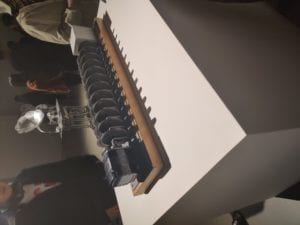Before I went to the Chronus exhibition, I only attended non-technology based art exhibition such as Pompidou art exhibition. I found that the initial intention of every exhibition is to let the audience identify with the artists and to know what the artists are trying to express through their artwork. This was also included in my experience in the Chronus exhibition. When I was trying to understand the projects in the Chronus exhibition, I focused more on how these projects worked with application of various technology which was similar to my attempt to find out what means of artistic expression are used in non-technology based art exhibition.As for the “Beholding the Big Bang” project made by Arthur Ganson, its appearance was merely some gears rotating at different speed and some of them were even still. After careful observation and reading the introduction of the project, I had a feeling of being suddenly enlightened. I understood that there was a motor that drove those gears which reduced the motor speed so that the final gear would take 13.82 billion years to rotate once.

The reason why my experience in the Chronus exhibition was unique to me was that every project in this exhibition contained a lot of interactions either with itself or with the audience, which normally would not exist in non-technology based art exhibition. Take the project that’s called “Artificial Intuition” made by Zhang Hua, the audience’s movement would be displayed on the screen in the corner and the branch-like machine would react to the movement accordingly.

This interactive experience would not take place in other non-technology based art exhibition for the reason that audience can just statically appreciate the art pieces that would not make any response to any of behavior.
Research
The two projects that I chose for my research were “Epilog” by Schnellebuntebilder and “Hertzian Landscapes” created by Richard Vijgen. I would argue that the “Epilog” is the project that better aligns with my understand of a good interactive project compared with “Hertzian Landscapes”. To begin with, my personal understanding involves three things.
1. It has to involve reciprocal actions that generate on-going effects on each other and contain physical input and output to each other as well.
2. The interaction between the project and the users should be obvious and easy for the users to detect and understand. It is better if the interaction is between the project and users directly.
3. the users should know the purpose of why they are interacting with the project with as least instruction as possible, thus knowing what they want to achieve through the interaction and understanding what outcomes would take place resulting from their actions.
As for the “Epilog”, it satisfies all the three needs that I think of for a successful interactive project .This project is basically a room installation that uses light, sound and haze to create a 25-minute constantly transforming world of moving images and sounds according to the visitors’ own moving pattern. For one thing, the user-project interaction is easy to understand because the stunning shadow and light effect that is projected on the ground would change dramatically in response to the users’ movement. Both of the mutual on-going effect on both the user and the project and users’s purpose of keeping interacting with it are both clear: when users move, the lighting and shadowing effect would change accordingly and on knowing the result of their actions, users would continue to change their movements in order to explore how many effects their actions could cause.
However, for the “Hertzian Landscapes” project, it is a live visualization of the radio spectrum. It includes a digital receiver to scan large swaths of radio spectrum in near real-time and using Three.js visualises thousands of signals into a panoramic electromagnetic landscape. If we just evaluate this project only in terms of its interaction without taking its practical use into account, it is definitely not as good as the “Epilog”. For one thing, the interaction is between the radio spectrum and the display screen without any user-project interaction. As users, the only thing that they could do is to stand in front of the project and observe the change of the screen. The interaction is very difficult to understand for the reason that if one want to understand exactly how the display screen would change according to the change of the radio spectrum, one must know the some professional knowledge about these concepts. Therefore, the interaction in this project is difficult to understand which doesn’t align with my understanding of a successful interactive project.
My original definition of “interaction” is : a cyclic process in which at least two characters alternatively input from the physical world, process and output based on my group project and the previous research. During the process of working on my midterm project and learning from the comments on my project, I found that a good interactive project should lay more emphasis on perfecting the interaction between the project and the users based on the users’ perspective. Therefore, a straightforward interaction that users could easily understand is a necessary component of a good interactive project. According to a quote in the article called “Making Interactive Art: Set the Stage, Then Shut Up and Listen”: “Your task in designing an interactive artwork is to give your audience the basic context, then get out of their way.”In order to let the users explore the project without feeling at lost at one point on their own, the interaction should be as straightforward enough. Beyond that, the users should know how their actions would cause a series of change directly, which means that they need to get instant feedback, in order to take the interacting experience with users to the next step. Another thing is that the users should know why they should complete such interactions with the project, in other words, users should be given a sense of purpose when interacting with projects.
Bibliography